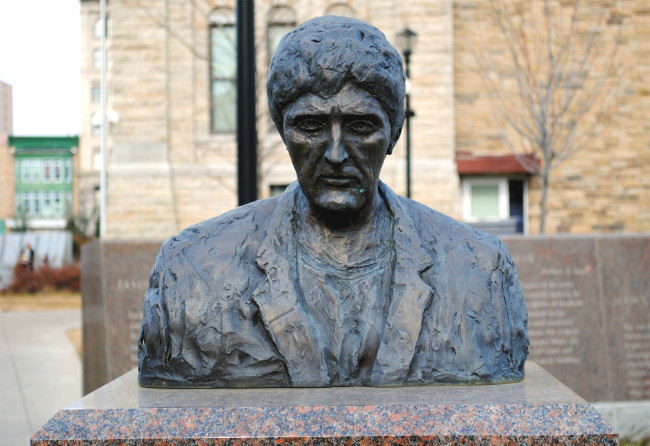ARCHIVES: Paul Sorvino remembers ‘artistic brother’ Jason Miller as Broadway revives ‘Championship Season’

When Paul Sorvino first met playwright and fellow actor Jason Miller, he immediately left a lasting impression as they locked eyes with a look he would never forget. Within hours of their first meeting, Sorvino was sure that his life, and his career, would be changed forever by the man and his work.
As Miller’s Pulitzer Prize-winning play “That Championship Season” begins its limited engagement Broadway revival this month, Sorvino was more than happy to recall his time starring in the original, critically acclaimed 1972 debut, filming subsequent movie adaptations, and becoming best friends with Miller himself, which led to a bond with the people of Miller’s hometown of Scranton that he feels still exists to this day.
“Haunted” by Miller
Almost out of the blue in the early 1970s, the then up-and-coming stage actor was asked to attend a meeting with Miller to discuss a potential role in his newest play. When he arrived, he was “immediately” impressed by what he saw.
“He had that haunted, extreme gravitas look in his eyes. He had extraordinary presence,” Sorvino described. “There was something in his face and his eyes.”
Curious as to why they “seemed so well disposed” toward him at the meeting, Sorvino began to read the play to himself on his way home.
“I started reading it as I was walking down the steps at page one. I lived in Tenafly, New Jersey at the time and, driving home, I was reading it at stoplights and traffic jams. By the time I got into Tenafly, I was in the third act. I walked into the kitchen, put up my hands and said, ‘I can’t speak. I’m reading this great play.’ I finished reading it in about 10 minutes, looked up with tears in my eyes and said to my wife, ‘This is the greatest play since ‘Death of a Salesman.’ If I do this in New York, I’ll become a star in one night,’” he said.
“And it kind of happened that way.”
“Season” championed on Broadway
He accepted the role of businessman Phil Romano alongside Charles Durning, Michael McGuire, Walter McGinn, and Richard Dysart. Opening May 2, 1972 at The Public Theater, it quickly gained popularity during 144 performances and transferred to Broadway’s Booth in September of 1972, where it ran for another 700 shows. Sorvino received a Tony Award nomination and a New York Drama Critics Award for Best Actor in 1973, instantly making him a star.
“I was hailed as the new guy on the block, almost unanimously, if you look at the reviews,” he said.
Even actor George C. Scott, who he admits he “didn’t get along with” while filming 1973’s “Day of the Dolphin,” had nothing but accolades for him.
“On opening night, he came back with tears in his eyes, threw his arms around me, and said, ‘Enjoy it. You may not get this again for 20 years.’ It was great praise, indeed,” Sorvino recalled.
Even today, he said, 39 years after its debut, he continues to hear from people who were touched by his fateful Broadway run. A friend of his son’s called him recently just to tell him that he saw his celebrated performance five times in a row on stage.
“He said, ‘You have no idea what it meant to me.’ I said, ‘What it means to me for you to say this to me this many years down the road is but another vindication of how I felt when I was doing it, what I thought of it, and my good work, I believe, in it.’”
It came as no surprise, then, when he heard of its revival featuring an all-star cast of Kiefer Sutherland, Brian Cox, Jim Gaffigan, Chris Noth, and Jason Patric, Miller’s own son.
“It should be revived. It’s a great play. It owes me nothing anymore. I got everything I ever wanted out of that play. … I wish them all so well with it. It’s a great piece. I hope they penetrate it fully because it’s not an actor-proof piece,” Sorvino noted.
“Something has to happen. It’s like a jazz group. One guy can’t sell it. They’re going to have to find as a company, as a cast, that common thread. We felt like a great jazz group when we were doing it, especially the boys. … When your riff was finished, I’d take mine. We worked off each other so well, and then we would go out together afterwards. It was a family. It truly was, with all of its difficulties and all of its triumphs and all of its losses.
“It’s a great play. It’s the greatest play about loss I know. It’s more than emotional loss. It’s a great, deep, penetrating work about the sense of loss in our lives. What happened to the boys of summer? Youthful dreams gone wrong. … You could see that Jason was all over it. You could see the path.”
Creative brothers
The play would not be the last time that he and Miller worked together, and it would only be the beginning of their friendship. Sorvino reprises his role in “That Championship Season” for Miller’s 1982 film, which was both set and filmed in Scranton. Miller had no control over the casting of Robert Mitchum as the Coach, however, which Sorvino felt hurt the production.
“The first movie had some problems. It was a time in Mitchum’s life when acting wasn’t a powerful thing anymore. He wasn’t the Coach. He kind of just stayed there and let it happen, which you can’t do,” he emphasized.
It was this that prompted Sorvino to remake the film in 1999, working closely with the playwright to make sure it was closer to his original vision. In this version, Sorvino played the Coach alongside Vincent D’Onofrio, Terry Kinney, Tony Shalhoub, and Gary Sinise.
“I decided that I wanted to set it right and give everything the play had to offer. They wanted me to direct something at Showtime, so I saw the opportunity, asked, and they said, ‘OK,” he explained. “It was a truer rendition of the play. … Jason was very happy with it.”
The men grew close both personally and creatively, staying in touch over the years through regular visits and phone calls.
“He felt that I was his artistic brother, in a way. He felt that we were, to use my daughter’s phrase, on the same sheet of music,” Sorvino remembered.
“He had said to me originally, when the play had had all of that success on Broadway and off-Broadway, ‘You’re the soul of my play.’ We were very good friends. He was like a brother I would see every six months or so, and I thought him to be one of the most intelligent, talented people on the face of the Earth. I still think that.”
Unfortunately, Miller’s lifelong struggle with alcoholism began to take its toll on the gifted actor and writer, a battle that Sorvino was forced to watch helplessly.
“It’s like watching your brother’s house burn down. You let the police in, you let the firemen in, but you just couldn’t reach him. It’s very hard to watch when that gigantic a talent, who was really the end of a small list of great playwrights, go through that,” he said.
“It’s a sad story. He was really, to me, the last of that great list.”
Returning to Scranton for Miller’s funeral when a sudden heart attack claimed his life at age 62, Sorvino knew that was just as much a loss for him as it was for his hometown.
“It was a communal loss for all of us. How do you lose such a great one? You don’t do it with equanimity, I’ll tell you that. When you see a great one go down, it’s like losing the Titanic. This was a titanicly talented human being. A great, enormous gift was given by God to one man.”
Love letter in Scranton
While the 1982 film version of “That Championship Season” wasn’t what many had hoped it would be, Sorvino credits his time spent in the area shooting the movie with an enduring affection for Northeastern Pennsylvania, eventually purchasing a home in the Pocono Mountains and shooting his own independent film in Scranton called “The Trouble with Cali” in 2005, which he added he would be “finishing shortly.”
“It started a lifelong love affair with Scranton for me because I got to know so many people who are now my dearest friends,” he said.
“It’s just one of those unusual, wonderful little places on the planet that you feel connected to. It’s like a second home to me.”
As a professional sculptor, Sorvino was asked by the city to create a bronze bust of his longtime friend, unveiled in December of 2008. It took him a year to capture his friend as he remembered him, giving it three separate tries and countless hours of studying his pictures and pausing his films.
“Any competent sculptor can make something look reasonably like the subject. The question is, ‘When is it going to be born? When is it going to have life?’ I must have worked on those eyes for a month alone,” Sorvino said.
“With all of my sculpture, I wait until it does something to me, emotionally, or it’s not done. … I’m still thrilled that I did it. I’m very proud of it. I tell everybody about it. I’m proud to know the people. I’m proud to be there. I’m proud that I knew the man. I’m proud that I did a good job, and I know that I did a good job.”
He said he wanted the statue to be Miller, not just resemble him, and as much as the bust overlooking Courthouse Square encompasses Miller’s passion for the city, it also represents the passion of its sculptor.
“It was almost a mission for my dear, dear departed friend and for all those people who wanted this in Scranton. In a way, it’s my love letter to him, but it allows me to let Jason keep giving his love back to them. He loved Scranton very, very, very much. It was the only place he felt home,” Sorvino continued.
“I’m very happy that I got a chance, the opportunity, to express that to the town, which I love, and to my dear friend, who I loved.”
Even today, it still brings him back to that one fateful meeting, that one singular “haunted” look, over four decades ago.
“The face on the statue, if you look directly into his eyes, is almost exactly the impression of the face that I saw the first time I laid eyes on him.”
Photo of Jason Miller bust by Rich Howells/NEPA Scene



